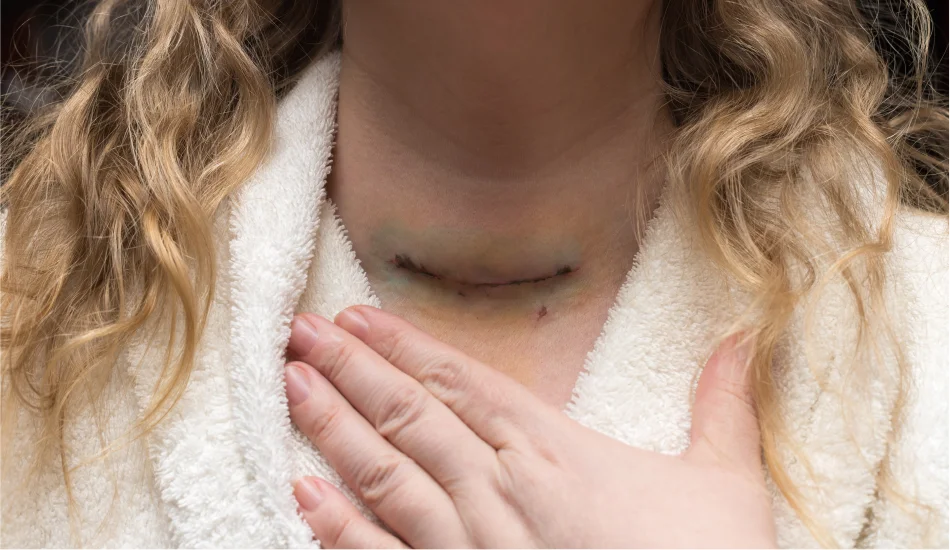
Thyroidectomy, the removal surgically of all or a part of the thyroid gland is a standard procedure to treat many thyroid conditions such as goiter, thyroid cancer and hyperthyroidism. Although thyroidectomy is generally safe, just like any other surgery, it is accompanied by some risks and complications. Knowing these risks and how to reduce them can ensure a faster recovery and improved overall results. In this post, we’ll go over the different kinds of thyroidectomy, explore the potential risks, and provide suggestions on how to reduce risks that come with thyroid removal.
Understanding Thyroidectomy
Thyroidectomy is an operation that requires taking out the thyroid gland. It is an organ that is shaped like a butterfly and located in the middle on the neck. This gland plays a vital function in controlling energy production, metabolism, and calcium levels within the body by regulating hormone production. Thyroidectomy is suggested for a variety of reasons.
- Thyroid Cancer :- Thyroid cancer is removed.
- Goiter :- A large, benign expansion in the thyroid gland, causing symptoms such as breathing and difficulties swallowing.
- Hyperthyroidism :- Hyperactive thyroid that is not managed with medication or other methods.
Different Types of Thyroidectomy
There are a variety of kinds of thyroidectomy, each one tailored to specific ailments and the needs of patients:
- Total Thyroidectomy :- Thyroidectomy total is the total elimination of thyroid gland. It is generally advised for people suffering from thyroid cancer, or for those suffering from large goiters affecting the whole gland. This treatment reduces the chance of cancer spreading to the thyroid. It is typically coupled with thyroid hormone therapy to keep healthy hormone levels.
- Subtotal or Near-Total Thyroidectomy :- In the process of undertotal thyroidectomy procedure, the majority part of the thyroid gland will be removed leaving only a small amount of tissue. This procedure is often employed to treat issues such as hyperthyroidism, where the entire thyroid gland doesn’t require removal. The near-total thyroidectomy works similarly however it leaves more thyroid tissues.
- Lobectomy (Hemithyroidectomy) :-Lobectomy Lobectomy involves the removal of only one thyroid gland. The procedure is usually done when only one thyroid nodule has been identified or in cases of hyperthyroidism. It permits the thyroid tissue remaining to continue to produce hormones, thereby reducing the requirement for hormone replacement treatment.
- Isthmusectomy :- A isthmusectomy is eliminating the isthmus, which is the thin tissue that connects the two thyroid gland lobes. This type of procedure is rare and typically reserved for conditions that affect the isthmus only.
Potential Complications of Thyroidectomy
Although thyroidectomy is typically considered to be safe, it is essential not to overlook the potential complications:
- Hypocalcemia :- The parathyroid glands are located close to the thyroid, assist in to regulate the levels of calcium within the body. When thyroidectomy is performed this gland can be injured or taken out, which can lead to hypocalcemia which is a condition that causes low levels of calcium. It is characterized by muscle cramps, tingling and, in extreme instances, cardiac problems.
- Voice Changes :- The laryngeal nerve which regulates vocal cords could be impacted during thyroid surgery, resulting in hoarseness and changes in voice. The majority of voice changes are temporary, however permanent changes may be experienced if the nerve damaged.
- Bleeding and Hematoma :- The risk of bleeding is high in any surgical procedure. When it comes to thyroidectomy, bleeding that is excessive could lead to the development of a hemoglobin which could cause an airway pressure, and may require an emergency intervention.
- Infection :- Although uncommon, infections at the surgical site may occur. A proper wound care regimen and hygiene is essential to stop infections.
- Scar Formation :- The process of scarring is an integral aspect of healing, but hypertrophic or keloid-like scars can be seen in certain patients. The scars may be more visible and require further treatment.
Tips for Minimizing Complications
To reduce the risk that come with thyroidectomy Patients and health professionals can take a variety of proactive actions:
- Choose an Experienced Surgeon :- Picking the most suitable doctor for thyroid surgery is essential to avoid complications. The surgeons with experience have a higher likelihood to have refined their techniques and skills that result in better outcomes and fewer risk. Examine the credentials of the surgeon and ask for recommendations and share their experience in thyroid surgery.
- Preoperative Assessment :- A thorough preoperative evaluation will allow you to determine risks and help make sure that the patient is prepared for surgery:
- Medical Examining :- Discuss your medical history, medications, as well as any other health issues you may have with your surgeon.
- Imaging and Tests :- Studies in imaging and lab tests can assist the surgical team design an operation and plan ahead for any challenges.
- Follow Postoperative Instructions :- Following the postoperative care guidelines is vital to minimize complications:
- Wound Treatment :- Keep the surgical site clean and dry. Follow the instructions of your surgeon for changing dressings and bathing.
- Medical Management :- Use prescribed medication for pain relief, such as painkillers or thyroid hormone supplements according to the directions.
- Monitor for Symptoms :- Be alert for any symptoms of complications and seek medical attention if necessary:
- Hypocalcemia Signs :- Report symptoms such as muscle cramps, tingling and fatigue, to your doctor.
- voice changes :- Tell your physician about any changes to your voice or difficulties speaking.
- Lifestyle Modifications :- Follow-up appointments regularly for your doctor are crucial to monitor your recovery
- Assessment of Healing :- The surgeon you choose will examine the healing process and address any concerns.
- Adjusting Medications :- Thyroid hormone levels might require monitoring and adjusted if needed.
Conclusion
Thyroidectomy is a crucial procedure to treat a variety of thyroid disorders, and knowing how to reduce the risk of complications is essential to the successful recovery. When choosing a skilled surgeon while adhering to the instructions for postoperative and preoperative procedures, and keeping an eye out for possible complications, patients can manage thyroid surgery with confidence and enjoy favorable results.
If you’re considering thyroid removal, it’s important to consult skilled professionals. The Best Thyroid Surgeons in Mira Bhayandar, our team of experienced surgeons offers complete thyroidectomy care and ensures the highest possible results to our clients. With the goal of providing care that is patient-centered and the most advanced surgical techniques, Chirayu Super Speciality Hospital is dedicated to assisting you to achieve an efficient and safe recovery.



